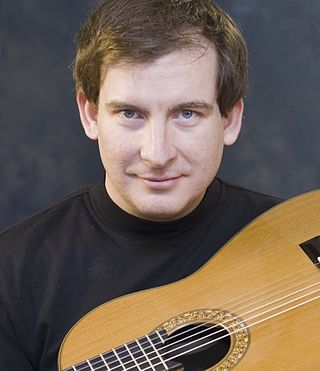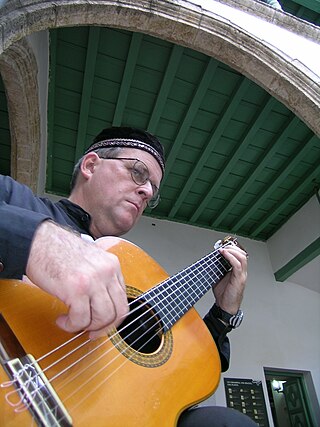Related Research Articles
The music of Cuba, including its instruments, performance, and dance, comprises a large set of unique traditions influenced mostly by west African and European music. Due to the syncretic nature of most of its genres, Cuban music is often considered one of the richest and most influential regional music in the world. For instance, the son cubano merges an adapted Spanish guitar (tres), melody, harmony, and lyrical traditions with Afro-Cuban percussion and rhythms. Almost nothing remains of the original native traditions, since the native population was exterminated in the 16th century.
The tres is a three-course chordophone of Cuban origin. The most widespread variety of the instrument is the original Cuban tres with six strings. Its sound has become a defining characteristic of the Cuban son and it is commonly played in a variety of Afro-Cuban genres. In the 1930s, the instrument was adapted into the Puerto Rican tres, which has nine strings and a body similar to that of the cuatro.

Trova is a style of Cuban popular music originating in the 19th century. Trova was created by itinerant musicians known as trovadores who travelled around Cuba's Oriente province, especially Santiago de Cuba, and earned their living by singing and playing the guitar. According to nueva trova musician Noel Nicola, Cuban trovadors sang original songs or songs written by contemporaries, accompanied themselves on guitar, and aimed to feature music that had a poetic sensibility. This definition fits best the singers of boleros, and less well the Afrocubans singing funky sones or even guaguancós and abakuá. It rules out, perhaps unfairly, singers who accompanied themselves on the piano.
Isaac Nicola Romero was a Cuban guitarist and one of the founders of the modern Cuban Guitar School. He was also brother of Clara (Cuqui) Nicola.

Alfredo Boloña Jiménez was a Cuban guitarist who played a role in the early development of the son as director of the Sexteto Boloña.

Ernesto Tamayo was a Cuban classical guitarist who toured extensively throughout North and South America and Europe.

Cecilia Arizti Sobrino was a Cuban composer, pianist and music educator.
Flores Chaviano is an accomplished Cuban composer, guitarist, professor and orchestral conductor that has achieved great international recognition.
Julio Roloff is a Cuban composer that has collaborated with the Laboratorio Nacional de Música Electroacústica (LNME) founded by composer Juan Blanco, where he created numerous electroacoustic pieces.
Efraín Amador Piñero is a Cuban guitarist, lutist, composer and professor. He has conducted extensive investigations about the “Cuban lute” and “tres” performance styles, and has created several methods of study and numerous compositions for those instruments.

Marta Cuervo was a Cuban guitarist and professor.
The guitar was the first instrument that was heard in Cuba after the conch horns, flutes and drums that the original aborigines used to play; as it was documented by Spanish chroniclers such as Bernal Díaz del Castillo. Through the centuries, the guitar has continued to be one of the most important and cherished instruments in Cuba, both in the practice of popular music as well as in the classical music tradition. Founded by renowned professors such as Clara Romero, Isaac Nicola, Clara (Cuqui) Nicola, Carlos Molina, and Marta Cuervo Riverón, the Cuban guitar school has acquired an excellent international reputation since the 20th century, represented by important instrumentalists and composers such as Leo Brouwer, Carlos Molina, José Rey de la Torre, Juan Antonio Mercadal and Joaquín Clerch, among many others.

Luis Manuel Molina de Varona is a Cuban musician, concert guitarist, composer, arranger, musical director, broadcaster and radio producer.
After its arrival in Cuba at the end of the 18th century, the pianoforte rapidly became one of the favorite instruments among the Cuban population. Along with the humble guitar, the piano accompanied the popular Cuban guarachas and contradanzas at salons and ballrooms in Havana and all over the country.

Clara (Cuqui) Nicola was a prominent Cuban guitarist and professor.
Miguel Bonachea is a Cuban guitarist and professor.
The bowed string instruments have been always present in Cuba since its discovery, first as the viol or bowed vihuela and at a later time as the Italian violin. As other instruments and the culture in general, also the violin enjoyed in Cuba a period of great relevance during the 19th century. The violin was part of the instrumental ensembles that accompanied the Contradance and the Dance, the first Cuban musical genres, as well as other subsequent genres as the Danzón and the Cha cha cha. The violin also intoned some of the most beautiful melodies composed in Cuba, such as "La Bella Cubana" by José White. At all times, the Cuban violinists have been prominent representatives of the Cuban music throughout the entire world.
Alejandro González González is a Cuban musician, guitarist and professor with notable work in the Dominican Republic.
The Barcelona Guitar Orchestra is a 25 chair orchestra of classical guitarists based in Barcelona, Spain. The repertoire of the orchestra ranges from Baroque to contemporary compositions with a heavy emphasis on Spanish music. In the more than thirty years since its founding, the orchestra has toured extensively throughout the world. It is considered an examplar of groups of its type.
Ñico Rojas was a prominent Cuban composer and guitarist, considered as one of the founders of a style of Cuban song called filin.
References
- 1 2 3 Miami Dade College.Carlos Molina.http://www.mdc.edu/kendall/mtd/music_adjunct_molina.asp
- 1 2 Orovio, Helio. Cuban Music from A to Z.Tumi Music Ltd. Bath, UK, 2004.
- 1 2 3 4 MCGS Founder Carlos Molina.http://www.miamiguitar.org/index.php?module=pagemaster&PAGE_user_op=view_page&PAGE_id=9&MMN_position=31:31
- ↑ "Leo Brouwer, Afro-Cuban Composer, Guitarist & Conductor".
- ↑ "Home". miamiguitar.org.
- ↑ Knights Arts. Society spreads the gospel of classical guitar.http://www.knightarts.org/community/miami/society-spreads-the-gospel-of-classical-guitar http://www.knightarts.org/community/miami/society-spreads-the-gospel-of-classical-guitar Archived 2012-06-14 at the Wayback Machine ;